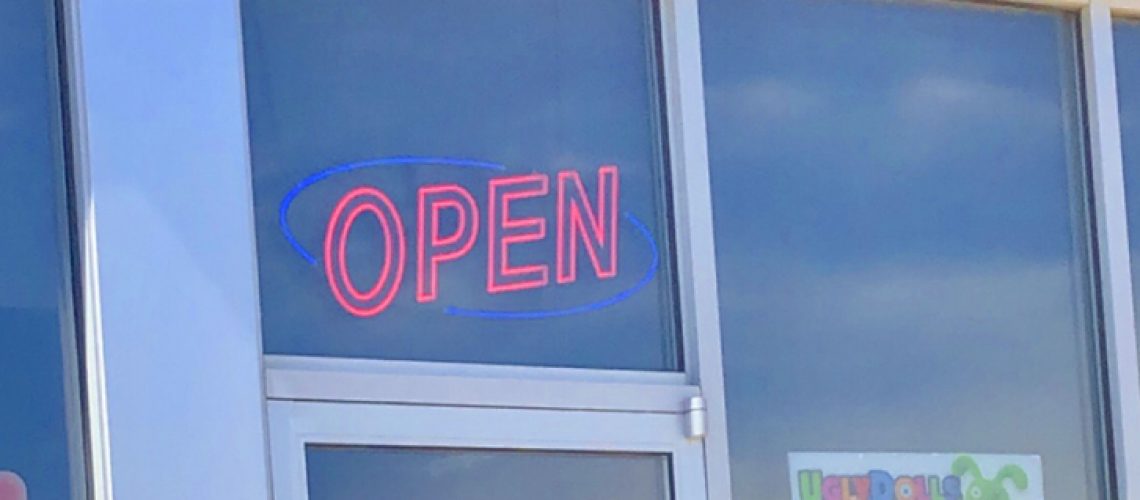This past weekend our family wanted to go for an ice cream run after enjoying an afternoon in the sun. We checked online to be sure a local creamery near us was open. Their Facebook page, Google listing, and website all indicated OPEN. We even called, just to be sure. There was no answer or even a recorded message saying they were closed, so we assumed that everyone had the same brilliant idea we did and they were too busy to answer. So we hopped in the car. Got the little one all secure in the car seat and headed that way. As we drive up, I noticed the parking lot was empty … “oh no they weren’t too busy to answer.” But as we got closer we could see the sign was lit up OPEN, so we were still hopeful. But alas as you expected – disappointment set in because on the door we found a small sign saying they were closed for the day in observance of the holiday. Which is an acceptable reason to be closed, but why did we have to come all the way to their store to find out? Nevertheless, it was a good day and we weren’t going to let this stop us. We wanted ice cream. So we got back on our phones and called around. The next place also had online platforms indicating they were open. But this time we called and they answered the phone, but when we said we were calling to see if they were open they declared “we are closed today for the holiday.” Wait – what? You are closed? But you answered the phone??? Perplexed, but determined, we moved on to the next location. Their social platforms indicated they were open, they answered the phone, and to our delight… they were open! So we proceeded to their location.
Open – Closed – Open, but Closed or Open? Are you sending mixed signals with your multi-channel marketing efforts?
By now everyone is at least entertaining the multi-channel approach to marketing, but whether or not they have a strategy or succinct campaign behind it is the question. Some, as we discussed, are merely checking the box and have become checklist marketers. There is no real strategy or data behind what channel they are using and why. One of the biggest mistakes made when choosing this approach is not being consistent across all channels, which ultimately results in sending mixed signals.
What kind of mixed signals are you sending? Are all your channels telling the same story? Is your messaging consistent?
So many questions… Maybe it is as simple as not taking the time to update holiday hours, updating the web address, or maybe it is even bigger and the content and messaging you are putting out there isn’t in line with your brand promise. Having accurate targeted messaging for your audience will help you be a brand of your word. Having some sort of consistency will help your audience trust what they have found is accurate.
If you know that 85% of people are searching using mobile devices for “ice cream near me” why wouldn’t you take the time to update the information? Pro tip – most of the platforms have a special hours section where you can schedule in all your holiday hours and closures ahead of time. Saves you time and allows for the customer to have accurate information. The platforms know this is important so they offer this value add because they understand how important it is to you and how busy you can get around those significant times, so they make it as easy as possible for you.
The customer experience is arguably one of the most important competitive advantages you have. No one can replicate you and the experience they have with you. The little things that shine through with consistency help push that customer experience to the next level. If the customer has the same experience no matter the channel, the value is immeasurable. The same is true if the experience is positive or negative as we know through our look into online reviews.
Why have all the channels if you don’t plan to maintain them and keep the information up to date? If you don’t think people are using them why have them in the first place?
Not every channel is appropriate for every business. While academics lump social media into one channel, typically not every social media platform is even needed. Determining your target audience and finding out where they live and play is key. Use only the platforms and channels that will reach your audience. Be efficient with your efforts and you will be more effective. While I love Twitter, if you don’t plan to tweet or have anything tweet worthy to say and your audience isn’t there to hear you say it, then don’t set up a Twitter. If you already have one but your analytics and data show you don’t need it – deactivate it or merely pin a tweet for any who might find you there as to where they might connect with you instead.
In the above example, the business had at least 3 opportunities to connect with the customer in a meaningful way. Online with social media, Google listing, and website; all of which could have had a post wishing customers well on the holiday and alerting them to the closure or special hours. The phone – could have had a voice messaging system to wish the callers well on the holiday and alert them of the special hours. Location – maybe turn the flashing OPEN sign off, so that the small personal sign on the door alerting visitors of the closing were both in agreement.
We ultimately found a place and enjoyed a cold sweet treat, but their lack of communication and mixed signals will be top of mind the next time we head out for a Sunday Funday adventure. If you just had a new epiphany and would like help drafting a strategic approach to your multi channel marketing, or you would appreciate an audit on how you can spark something new to improve your customer experience to match your brand promise, we would love to help! Or maybe this is a matter of not having the personnel trained to execute the plan, we can help with that as well.

